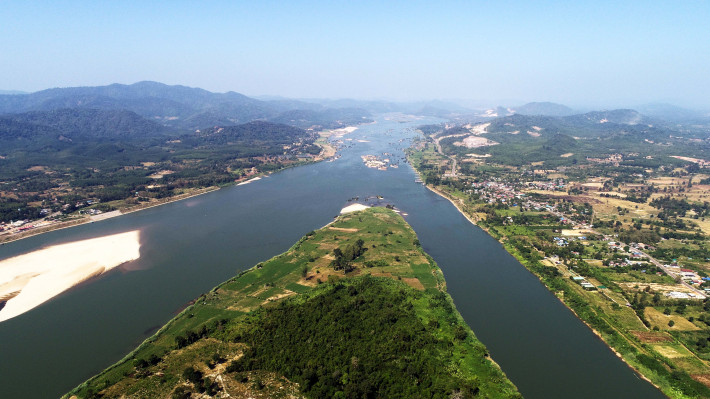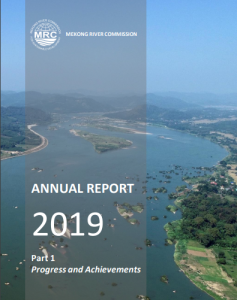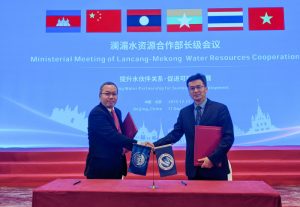New report warns flood and drought remain key challenges for Mekong River
- June 18, 2020
- Posted by: Elaine Coles
- Category: Water Issues, Asia

Extreme low flows and extensive flooding of different communities along the Mekong River in 2019 and an increasing number of droughts that have occurred in many parts of the region in recent years are among the signs that the Mekong region is facing increasing risk from extreme weather events and developments, says a new report by the Mekong River Commission (MRC).
Boosting regional efforts to provide faster and more accurate forecasting on flood and drought and to expand a network of hydro-meteorological  monitoring to collect data in the basin are critical in addressing these issues, according to the MRC’s 2019 Annual Report released this week.
monitoring to collect data in the basin are critical in addressing these issues, according to the MRC’s 2019 Annual Report released this week.
Launching the report, Dr An Pich Hatda, the MRC Secretariat’s Chief Executive Officer, commented:
“Flood and drought have hit our region hard lately and require stronger regional collaboration. The countries along the Lower Mekong River need to step up their collective efforts in addressing the problems facing them now and in the future, for example by ensuring transparency, quality and timeliness in water data sharing,”
“Modernising the existing data systems using advanced technology will be necessary.”
The 100-page long report, which takes stock of key progress and achievements the MRC scored last year, says “severe droughts in the Lower Mekong Basin (LMB) have caused substantial economic losses due to damages of agricultural crops, negative impacts on the environment, and adverse effects on people’s livelihoods”.
The drought in 2016, for example, brought serious economic losses to Thailand, estimated at US$1.7 billion, according to the MRC, which further notes that the LMB is likely to see more severe droughts in the next 30 to 90 years. Rapid water level fluctuations due to hydropower operations and flash floods due to climate change will also be future challenges.
New Drought Management Strategy in place for 2020-2025
One of the actions that the MRC took last year to respond to the problems, the report says, was developing a Drought Management Strategy for 2020-2025, as a strategic approach by the Member Countries to address the increasing risk of drought across the region.
The strategy focuses on five priority areas assessed as “poorly functioning” and requiring “immediate attention” to address droughts. They include drought indicator monitoring, drought forecasting and early warning, capacity building in drought assessment and planning, mitigation measures, and information sharing systems.
The MRC also expanded its scope of services and functions by integrating drought monitoring and management functions into the organisation’s current flood forecasting work, the report notes.
2019 – a year of increased partnership
Last year saw the MRC take a closer step to work with various partners, including China, Mekong Lancang Cooperation as well as civil society organisations and representatives of affected communities, to address flood and drought issues and to bring in more responsible and inclusive development.
The report also says that cooperation with the upstream country, where China is the MRC Dialogue Partner, also reached another level in 2019.
For example, China and other five member countries of the Lancang Mekong Cooperation (LMC) agreed to grant an “observer status” to the MRC Secretariat to attend annual meetings of the LMC’s Joint Working Group on Water Resources.
In addition, both the MRC Secretariat and LMC Water Centre inked an MOU after two years of negotiation. The technical cooperation would allow both sides to conduct data and information exchange, basin-wide monitoring, and joint assessment on Mekong water and related resources.
China also agreed to continue providing water-level and rainfall data to the MRC during flood season, starting from June 1 until October 31, every year for five years.
The near real-time data provided by China, the MRC says, has enabled Cambodia, Lao PDR, Thailand and Viet Nam to strengthen their river water-level monitoring and improve the accuracy of flood forecasting as well as mitigate the negative effects of flooding.
High level exchanges and visits to Australia’s Murray-Darling and the United States’ Mississippi and Columbia River basins, the report adds, have also opened up new perspectives on basin development and protection, drought relief and flood control.
The Annual Report for 2019 contains two parts. Part 1, available in soft and hard copies, covers key achievements at the level of outcomes regarding implementation of the overall MRC Strategic Plan 2016-2020 and Annual Work Plan 2019. It also includes a summarised financial report.
Part 2 is more detailed and available in an interactive format. It presents detailed progress reporting on the Annual Work Plan 2019 in terms of outputs and activities under each outcome, as well as detailed financial reporting.
